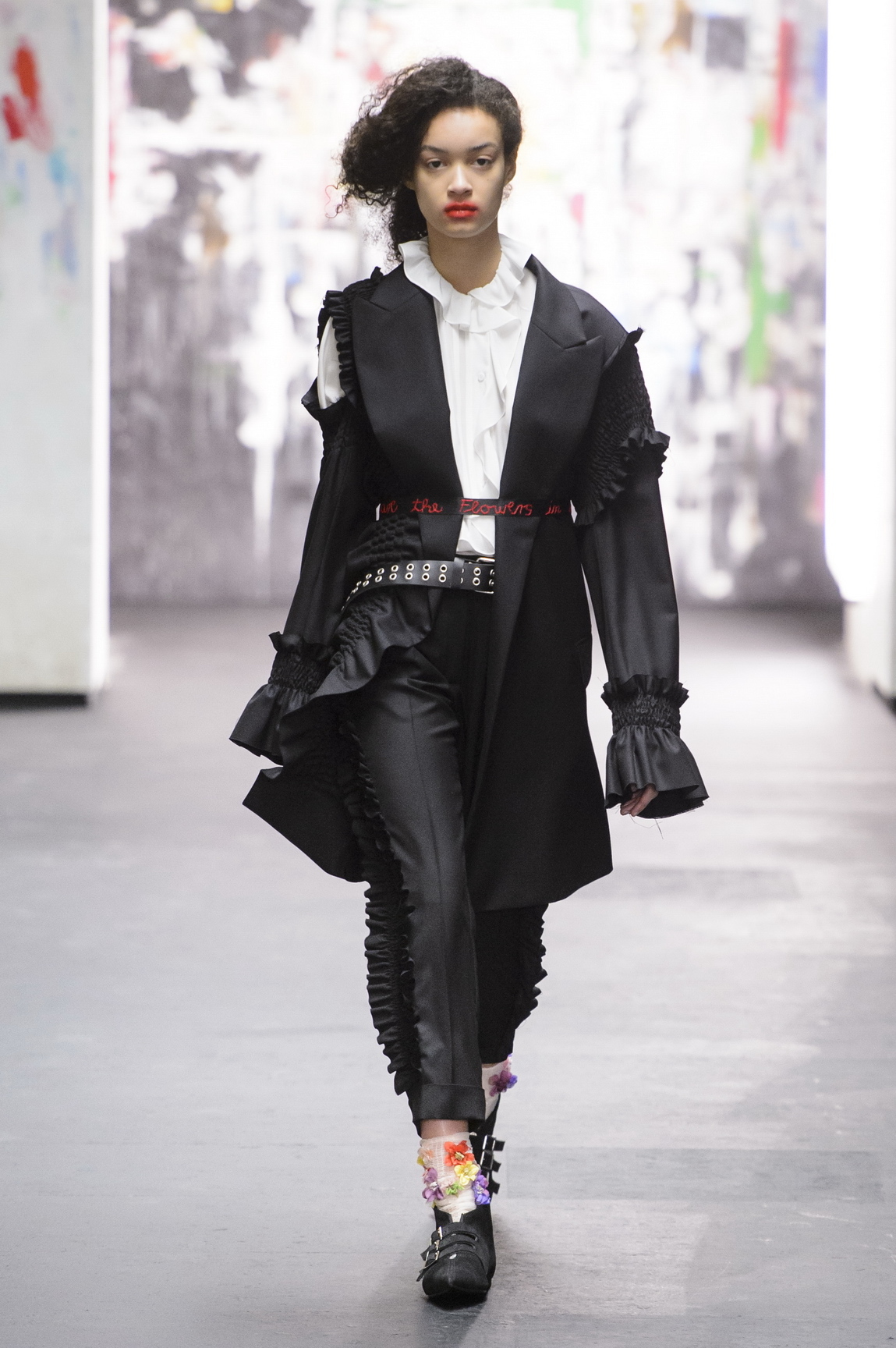Unlike Scotland or Germany, England has no official national dress. No kilts or lederhosen to get patriotic in at summer festivals — rather, the English pride themselves on morning suits and a solid countryside wardrobe. It provides endless inspiration for an outsider like Johnny Coca, whose Spanish eyes have turned Mulberry into the ideal image of the British heritage wardrobe. For fall/winter 17, his third season for the house, Coca gave those English clichés the subversive fashion treatment that feels very now. The recipe goes something like this: in lieu of a British national costume, find the most ordinary core-British reference and turn it upside-down. “For me it was a continuation,” he said of the collection, “because I was keeping the same love for everything I like in the UK: the countryside, the hunting, old wallpaper.” More specifically, he channeled the twee florals of countryside bed and breakfast rooms where every inch is covered in flower prints, and turned them into flouncy dresses worthy of the races. But they were somewhat deconstructed, peculiar in cut and a little bit weird in the right way, just like a quilted horse blanket had been turned into a kind of cape, or the crotchet and checks and granny jewelry of the British heritage wardrobe had all been reworked to fit that sense of oversized cool Coca works towards. In that transition, his best move was paying a visit to the mythical Mulberry Home archives where he found a lot of the components used in the collection. On the British-centric path he’s following for the house, you couldn’t wish for better national costume than the goldmines Mulberry sits on.

For a different segment of England, Topshop pretty much constitutes national dress. No brand is more worn from Cornwall to Newcastle and everywhere in between, and the references Kate Phelan works with — just like her colleague at Topman, Gordon — are intrinsic to the history of British youth culture. In their second see-now-buy-now show, Topshop Unique got their party on, painting a fairly accurate portrait of this country’s going-out culture. It wasn’t about sequined jumpsuits the glamorous way Halpern depicted New York nightlife the day before, but instead, the mini skirts and high-cut floral dresses and faux fur coats you’ll see walking down the street in any British city on a Saturday night — elevated, of course, for the runway. At Preen by Thornton Bregazzi, Justin (Thornton) and Thea (Bregazzi) had been looking at British women too, via the early-20th-century work of Scottish photographer Christina Broom, who documented suffragette marches in England. It resulted in another take on this country’s affinity for clashing floral prints, turned up to new volumes by the Preen designers, who added a fair amount boyish punk to mix as well — which, if anything, is part of England’s national costume. In her presentation at the Mondrian, A.V. Robertson took the British floral to a different level of subversion, styling up her masterly embroidered garments with flower-embellished gardening gloves. Following a Saturday in the name of emerging talent, Robertson was pretty much the only designer flying that flag on Sunday and her incredible embroidery and intrinsic Britishness definitely deserve a bigger platform.

Mary Katrantzou knows a thing or two about embellishment. Her collection, which was backed up live by the Philharmonic Orchestra, set its sights on Disney’s Fantasia, working in scenes from the classic animated film on garments. The motifs came to life through heavy embellishment in motion, where the surface of a dress — no matter how bejeweled — literally depicted a still from the film. It was childlike and magical in that Disney way you could never get enough of: if not a national language, then a global one we somehow all speak. You can’t say that for David Koma’s native Georgian tongue, although in recent years that country’s designers have had their share of influence on fashion — just look at Mulberry now. Koma has started a new, very personal chapter in his own evolution, looking at his childhood and upbringing, and it suits him. Last season he explored his teenage years in Saint Petersburg, and this season the time had come for his original roots in Georgia. He took the chokra — the Georgian national men’s dress, a uniform once worn in the battlefield and now mainly at weddings — and applied his 60s Space Age trademark to it, swapping Georgian cartridge embellishment for metal tubes and plexiglass and all the shiny modernism that makes his heart grow fonder. Koma’s new path really gives his work new character, and the necessary tools for him to evolve. As we learned on Sunday in London, there’s a lot to be said for national costume — even if Britain doesn’t have one. With the wealth of floral dresses that are hitting us this season, though, at least Hyacinth Bucket didn’t live in vain. Lady of the house speaking.

Credits
Text Anders Christian Madsen
Photography Mitchell Sams
